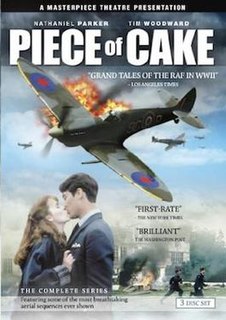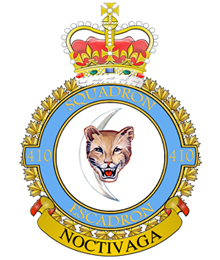
A night fighter is a fighter aircraft adapted for use at night or in other times of bad visibility. Night fighters began to be used in World War I and included types that were specifically modified to operate at night.

James Bigglesworth, nicknamed "Biggles", is a fictional pilot and adventurer, the title character and hero of the Biggles series of adventure books, written for young readers by W. E. Johns (1893–1968). Biggles made his first appearance in the story The White Fokker, published in the first issue of Popular Flying magazine and again as part of the first collection of Biggles stories, The Camels Are Coming. Johns continued to write "Biggles books" until his death in 1968. The series eventually spanned nearly a hundred volumes – including novels and short story collections – most of the latter with a common setting and time.
Derek Robinson is a British author best known for his military aviation novels full of black humour. He has also written several books on some of the more sordid events in the history of Bristol, his home town, as well as guides to rugby. He was nominated for the Booker Prize in 1971 for his first novel, Goshawk Squadron.
A hornet is an insect. It may also mean:
The phrase "piece of cake" generally refers to something that can be easily achieved.

Piece of Cake is a 1988 British six-part television serial depicting the life of a Royal Air Force fighter squadron from the day of the British entry into World War II through to one of the toughest days in the Battle of Britain. The series was produced by Holmes Associates for LWT for ITV and had a budget of 5 million pounds.
Piece of Cake is a 1983 novel by Derek Robinson which follows a fictional Royal Air Force fighter squadron through the first year of World War II, and the Battle of Britain. It was later made into the 1988 television serial Piece of Cake.
No. 213 Squadron was a squadron of the Royal Air Force. The squadron was formed on 1 April 1918 from No. 13 (Naval) Squadron of the Royal Naval Air Service. This RNAS squadron was itself formed on 15 January 1918 from the Seaplane Defence Flight which, since its creation in June 1917, had had the task of defending the seaplanes which flew out of Dunkirk.

No. 75 Squadron is a Royal Australian Air Force (RAAF) fighter unit based at RAAF Base Tindal in the Northern Territory. The squadron was formed in 1942 and saw extensive action in the South West Pacific theatre of World War II, operating P-40 Kittyhawks. It was disbanded in 1948, but reformed the following year and operated jet aircraft throughout the Cold War. The squadron was based at Malta from 1952 to 1954, flying de Havilland Vampires, and Malaysia from 1968 to 1983, with Dassault Mirage IIIs, before returning to Australia.

No. 1 Squadron is a Royal Australian Air Force (RAAF) squadron headquartered at RAAF Base Amberley, Queensland. Controlled by No. 82 Wing, it is equipped with Boeing F/A-18F Super Hornet multi-role fighters. The squadron was formed under the Australian Flying Corps in 1916 and saw action in the Sinai and Palestine Campaigns during World War I. It flew obsolete Royal Aircraft Factory B.E.2s, B.E.12s, Martinsyde G.100s and G.102s, as well as Airco DH.6s, Bristol Scouts and Nieuport 17s, before re-equipping with the R.E.8 in October 1917 and finally the Bristol Fighter in December. Its commanding officer in 1917–18 was Major Richard Williams, later known as the "Father of the RAAF". Disbanded in 1919, No. 1 Squadron was re-formed on paper as part of the RAAF in 1922, and re-established as an operational unit three years later.

No. 3 Squadron is a Royal Australian Air Force (RAAF) fighter squadron, headquartered at RAAF Base Williamtown, near Newcastle, New South Wales. Established in 1916, it was one of four combat squadrons of the Australian Flying Corps during World War I, and operated on the Western Front in France before being disbanded in 1919. It was re-raised as a permanent squadron of the RAAF in 1925, and during World War II operated in the Mediterranean Theatre. The Cold War years saw the squadron disbanded and re-raised twice. It was based at RAAF Butterworth during the Malayan Emergency and the Indonesia–Malaysia Konfrontasi. Equipped with McDonnell Douglas F/A-18 Hornet multi-role fighters from 1986, the squadron deployed to Diego Garcia in 2002 to provide local air defence, and the following year contributed aircraft and crews to the invasion of Iraq as part of Operation Falconer. In April 2016, it deployed to the Middle East as part of the military intervention against ISIL.

No. 77 Squadron is a Royal Australian Air Force (RAAF) squadron headquartered at RAAF Base Williamtown, New South Wales. It is controlled by No. 81 Wing, and equipped with McDonnell Douglas F/A-18 Hornet multi-role fighters. The squadron was formed at RAAF Station Pearce, Western Australia, in March 1942 and saw action in the South West Pacific theatre of World War II, operating Curtis P-40 Kittyhawks. After the war, it re-equipped with North American P-51 Mustangs and deployed to Japan as part of the British Commonwealth Occupation Force. The squadron was about to return to Australia when the Korean War broke out in June 1950, after which it joined United Nations forces supporting South Korea. It converted from Mustangs to Gloster Meteor jets between April and July 1951 and remained in Korea until October 1954, claiming five MiG-15s and over five thousand buildings and vehicles destroyed during the war for the loss of almost sixty aircraft, mainly to ground fire.
A fighter pilot is a military aviator trained to engage in air-to-air combat, air-to-ground combat and sometimes electronic warfare while in the cockpit of a fighter aircraft. Fighter pilots undergo specialized training in aerial warfare and dogfighting. A fighter pilot with at least five air-to-air kills becomes known as an ace.

Number 92 Squadron, also known as No. 92 Squadron and currently as No. 92 Tactics and Training Squadron, of the Royal Air Force is a test and evaluation squadron based at RAF Waddington, Lincolnshire. It was formed as part of the Royal Flying Corps at London Colney as a fighter squadron on 1 September 1917. It deployed to France in July 1918 and saw action for just four months, until the end of the war. During the conflict it flew both air superiority and direct ground support missions. It was disbanded at Eil on 7 August 1919. Reformed on 10 October 1939, the unit was supposed to be equipped with medium bombers but in the spring of 1940 it became one of the first RAF units to receive the Supermarine Spitfire, going on to fight in the Battle of Britain.

No. 81 Wing is responsible for operating the McDonnell Douglas F/A-18 Hornet multi-role fighters of the Royal Australian Air Force (RAAF). Headquartered at RAAF Base Williamtown, New South Wales, the wing comprises three combat units, Nos. 3 and 77 Squadrons based at Williamtown and No. 75 Squadron at RAAF Base Tindal, Northern Territory, as well as an operational conversion unit at Williamtown. No. 81 Wing headquarters oversees squadron training in air-to-air and air-to-ground tactics, and support for the Australian Army and Royal Australian Navy. Tasked with offensive and defensive counter-air operations, the Hornets have been deployed to Diego Garcia in 2001–02, when they provided local air defence, to Iraq in 2003, when they saw action flying fighter escort and close air support missions in concert with Coalition forces, and to the Middle East in 2015–16, when they undertook strike operations during the military intervention against ISIL. They have also been employed to patrol high-profile events in Australia, including the Commonwealth Games and visits by foreign dignitaries.

Ramat David Israeli Air Force Base is one of three principal airbases of the Israeli Air Force, located southeast of Haifa, close to kibbutz Ramat David and Megiddo in the Jezreel Valley. It was originally built as a Royal Air Force station in 1942 under the British Mandate when it was known as RAF Ramat David. In 2014, it was reported to be the most likely location for a new International airport to complement Ben Gurion Airport.
The Royal Air Force (RAF) and Fleet Air Arm had included personnel from outside the United Kingdom from before the beginning of the Second World War, and many served in the Battle of Britain of 1940. Many of these volunteers were British subjects—thus, citizens—coming from territories that made up part of the British Empire. Additionally, a significant part was made up of refugees and exiles from German-occupied Europe and American emigrants.

A Good Clean Fight is a 1993 novel by Derek Robinson, and a sequel to Piece of Cake (1983), his famous and controversial novel of the Battle of Britain. It continues the story of RAF Hornet Squadron, now posted to North Africa in 1942, during a lull in the fighting. Some of the characters from the previous novel, such as Squadron Leader "Fanny" Barton and erudite but iconoclastic intelligence officer "Skull" Skelton, reprise their roles. As the squadron engages in increasingly suicidal ground attacks in an effort to lure the Luftwaffe into a fight, Captain Jack Lampard leads an SAS patrol behind enemy lines and Paul Schramm, a German intelligence officer, tries to concoct his own scheme to beat the SAS at their own game.

No. 64 Squadron was a squadron of the Royal Air Force. It was first formed on 1 August 1916 as a squadron of the Royal Flying Corps. It was disbanded on 31 January 1991 at RAF Leuchars.

410 Tactical Fighter Operational Training Squadron, nicknamed the "Cougars", is a Royal Canadian Air Force aircraft squadron currently located at Canada's primary training base for the CF-18, at Cold Lake, Alberta. The squadron was formed during the Second World War as an RCAF squadron under the Royal Air Force (RAF), at RAF Ayr, near Prestwick, in Scotland.












